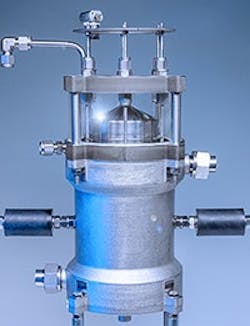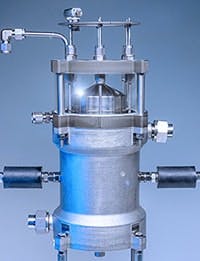Microreactor Tames Grignard Reagents
Figure 1. Magnesium plays a crucial role in easing syntheses using Grignard reagents. Source: Fraunhofer IMM.
Widely used in pharmaceutical, fragrance and flavoring processes to forge carbon-carbon bonds, Grignard reagents nevertheless pose serious processing challenges. Their reactions often start slowly and then progress rapidly and exothermically. Trying to control the speed and volume of their addition to a reactor helps — but also slows reaction time and allows formation of unwanted byproducts.After five years of work, researchers at the Fraunhofer Institute for Microengineering and Microsystems (IMM) in Mainz, Germany, have overcome these problems with a flow microreactor (Figure 1). It reduces reaction time to minutes while improving product purity and enabling its tailoring to specific requirements.
Their success lies in the new reactor’s design. Reactant is pumped up through a bed of magnesium shavings to control the rate of reaction. A double skin around the reactor uses oil cooling to dissipate heat. The short residence time that ensues, plus the abundance of magnesium which mops up byproducts, prevents side reactions.
A pilot plant that converts 20 L/hr of reactant solution — using four linked 500-mL reactors with throughputs of 0.5–5 L/hr —already is up and running. The only factors limiting the addition of more reactors are the magnesium remaining effective and being uniformly replenished in each reactor, says Gabriele Menges-Flanagan, research fellow with the flow chemistry group at IMM.
The entire development process so far has been carried out with help from industrial partners, she adds. Although their identities remain confidential, Menges-Flanagan believes that some might carry out pilot studies at their own facilities in 2022.
“The main chemical challenges to such a scale-up would be ensuring the applicability of the technology to the whole class of Grignard reagents from very reactive ones prone to side reactions as well as those rather sluggish and difficult even to initiate, while still achieving throughputs that are of industrial interest,” she explains.
Managing the magnesium in the process has posed the biggest engineering obstacle up to now, says Menges-Flanagan. “To achieve an even larger throughput, it would have to be considered to run a multiple reactor stack in parallel. The main challenges here are ensuring equal liquid and solid feed distribution,” she notes.
The Fraunhofer IMM team currently is using a similar laboratory-scale set-up to investigate synthesis of organometallic compounds of zinc.

